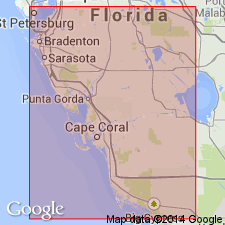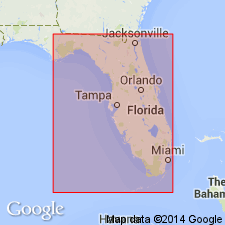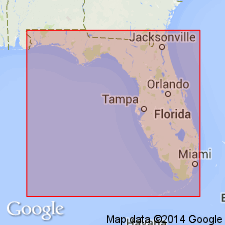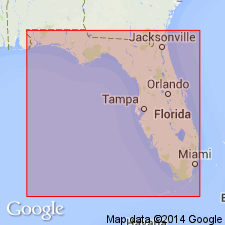
- Usage in publication:
-
- Murdock Station member
- Modifications:
-
- Named
- Dominant lithology:
-
- Sand
- AAPG geologic province:
-
- South Florida province
Summary:
Murdock Station member of Tamiami formation named in Charlotte Co., FL. Described as gray barnacle "hash," phosphatic sand, and pectin biostrome, 1 m thick. Underlies the Pinecrest sand member and overlies the Bayshore clay member (new name). Age is late Miocene. [Though unit is lowercased by author, intent to name as formal unit inferred.]
Source: GNU records (USGS DDS-6; Reston GNULEX).

- Usage in publication:
-
- Murdock Station Member
- Modifications:
-
- Not used
- AAPG geologic province:
-
- South Florida province
Summary:
Peace River Formation (new name) of Hawthorn Group includes siliciclastic beds previously placed in the Tamiami Formation by Parker (1951) and in the Murdock Station and Bayshore Clay Members of the Tamiami by Hunter (1968).
Source: GNU records (USGS DDS-6; Reston GNULEX).

- Usage in publication:
-
- Murdock Station Formation
- Modifications:
-
- Revised
- Age modified
- AAPG geologic province:
-
- Florida platform
Summary:
Tamiami Group (usage of DuBar, 1989) is divided into the lower Murdock Station Formation and the upper Sarasota Formation. In southwestern FL, the Murdock Station is a fossiliferous, argillaceous, locally phosphatic quartz sand, or cream-colored calcilutite averaging less than 3 m in thickness. Unit is considered to be middle or late Pliocene in age based on pelecypods. Equivalent deposits have not been recognized beyond southwestern FL.
Source: GNU records (USGS DDS-6; Reston GNULEX).

- Usage in publication:
-
- Murdock Station Member
- Modifications:
-
- Overview
- AAPG geologic province:
-
- Florida platform
Summary:
Author states that it is not clear how Petuch's (1988) Sarasota Member of the Hawthorn Formation differs faunistically from Hunter's (1968) Murdock Station Member of the Tamiami Formation. On the basis of the species Petuch (1982) listed in Unit 11 (now designated Sarasota Member), the unit might be assigned an early Pliocene age. Because of uncertainties in the relationship between these units, author continues to refer strata to the Tamiami, though Vokes (1988) preferred to call them Pinecrest beds.
Source: GNU records (USGS DDS-6; Reston GNULEX).
For more information, please contact Nancy Stamm, Geologic Names Committee Secretary.
Asterisk (*) indicates published by U.S. Geological Survey authors.
"No current usage" (†) implies that a name has been abandoned or has fallen into disuse. Former usage and, if known, replacement name given in parentheses ( ).
Slash (/) indicates name conflicts with nomenclatural guidelines (CSN, 1933; ACSN, 1961, 1970; NACSN, 1983, 2005, 2021). May be explained within brackets ([ ]).

